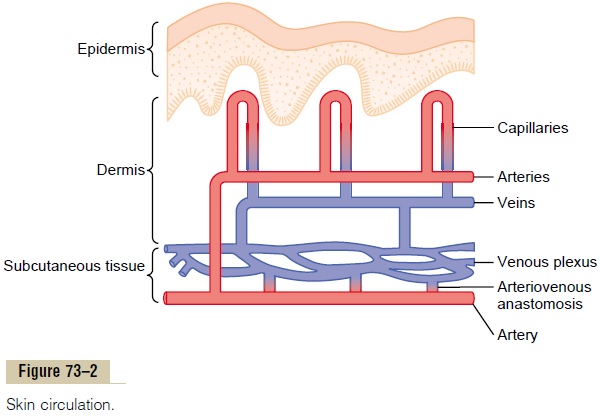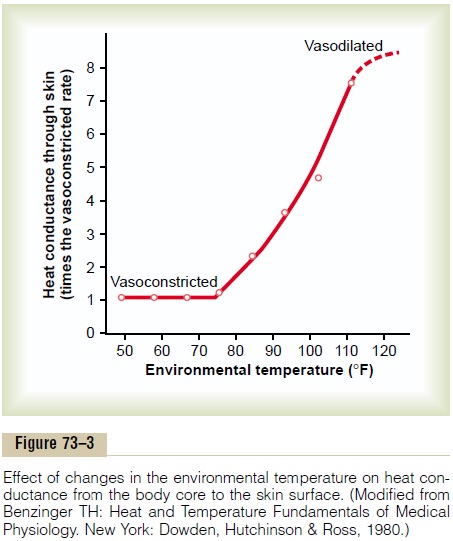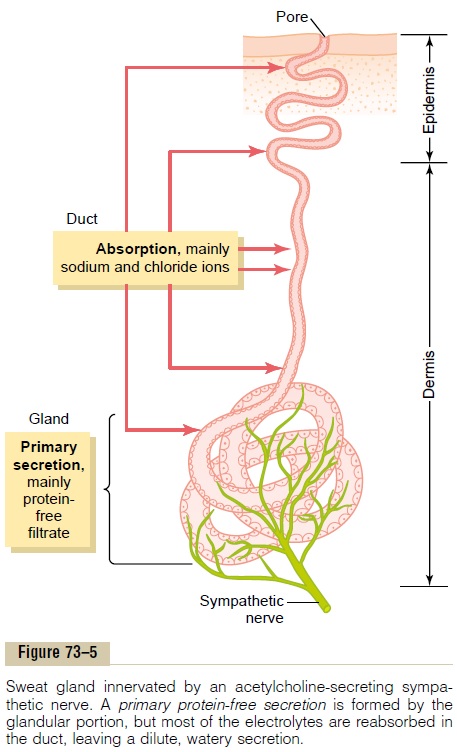Chapter: Medical Physiology: Body Temperature, Temperature Regulation, and Fever
Body Temperature Is Controlled by Balancing Heat Production Against Heat Loss
Body Temperature Is Controlled by Balancing Heat Production Against Heat Loss
When the rate of heat production in the body is greater than the rate at which heat is being lost, heat builds up in the body and the body temperature rises. Conversely, when heat loss is greater, both body heat and body temperature decrease.
Heat Production
Heat production is a principal by-product of metabolism. We discuss the different factors that determine the rate of heat production, called the metabolic rate of the body. The most impor-tant of these factors are listed again here: (1) basal rate of metabolism of all the cells of the body; (2) extra rate of metabolism caused by muscle activity, including muscle contractions caused by shivering; (3) extra metabolism caused by the effect of thyroxine (and, to a less extent, other hormones, such as growth hormone and testosterone) on the cells; (4) extra metabolism caused by the effect of epinephrine, nor-epinephrine, and sympathetic stimulation on the cells; (5) extra metabolism caused by increased chemical activity in the cells themselves, especially when the cell temperature increases; and (6) extra metabolism needed for digestion, absorption, and storage of food (thermogenic effect of food).
Heat Loss
Most of the heat produced in the body is generated in the deep organs, especially in the liver, brain, and heart, and in the skeletal muscles during exercise. Then this heat is transferred from the deeper organs and tissues to the skin, where it is lost to the air and other surroundings. Therefore, the rate at which heat is lost is determined almost entirely by two factors: (1) how rapidly heat can be conducted from where it is pro-duced in the body core to the skin and (2) how rapidly heat can then be transferred from the skin to the sur-roundings. Let us begin by discussing the system that insulates the core from the skin surface.
Insulator System of the Body
The skin, the subcutaneous tissues, and especially the fat of the subcutaneous tissues act together as a heat insulator for the body. The fat is important because it conducts heat only one third as readily as other tissues. When no blood is flowing from the heated internal organs to the skin, the insulating properties of the normal male body are about equal to three quarters the insulating properties of a usual suit of clothes. In women, this insulation is even better.
The insulation beneath the skin is an effective means of maintaining normal internal core tempera-ture, even though it allows the temperature of the skin to approach the temperature of the surroundings.
Blood Flow to the Skin from the Body Core Provides Heat Transfer
Blood vessels are distributed profusely beneath the skin. Especially important is a continuous venous plexus that is supplied by inflow of blood from the skin capillaries, shown in Figure 73–2. In the most exposed areas of the body—the hands, feet, and ears—blood is also supplied to the plexus directly from the small arteries through highly muscular arteriovenous anastomoses.

The rate of blood flow into the skin venous plexus can vary tremendously—from barely above zero to as great as 30 per cent of the total cardiac output. A high rate of skin flow causes heat to be conducted from the core of the body to the skin with great efficiency, whereas reduction in the rate of skin flow can decrease the heat conduction from the core to very little.
Figure 73–3 shows quantitatively the effect of envi-ronmental air temperature on conductance of heat from the core to the skin surface and then conductance into the air, demonstrating an approximate eightfold increase in heat conductance between the fully vaso-constricted state and the fully vasodilated state.

Therefore, the skin is an effective controlled “heatradiator” system, and the flow of blood to the skin is amost effective mechanism for heat transfer from the body core to the skin.
Control of Heat Conduction to the Skin by the Sympathetic Nervous System. Heat conduction to the skin by theblood is controlled by the degree of vasoconstriction of the arterioles and the arteriovenous anastomoses that supply blood to the venous plexus of the skin. This vasoconstriction is controlled almost entirely by the sympathetic nervous system in response to changes in body core temperature and changes in environmental temperature. This is discussed later in connection with control of body temperature by the hypothalamus.
Basic Physics of How Heat Is Lost from the Skin Surface
The various methods by which heat is lost from the skin to the surroundings are shown in Figure 73–4. They include radiation, conduction, and evaporation, which are explained next.
Radiation. As shown in Figure 73–4, in a nude personsitting inside at normal room temperature, about 60 per cent of total heat loss is by radiation.
Loss of heat by radiation means loss in the form of infrared heat rays, a type of electromagnetic wave. Most infrared heat rays that radiate from the body

have wavelengths of 5 to 20 micrometers, 10 to 30 times the wavelengths of light rays. All objects that are not at absolute zero temperature radiate such rays.The human body radiates heat rays in all directions. Heat rays are also being radiated from the walls of rooms and other objects toward the body. If the temperature of the body is greater than the temperature of the sur-roundings, a greater quantity of heat is radiated from the body than is radiated to the body.
Conduction. As shown in Figure 73–4, only minutequantities of heat, about 3 per cent, are normally lost from the body by direct conduction from the surface of the body to solid objects,such as a chair or a bed. Loss of heat by conduction to air, however, represents a sizable proportion of the body’s heat loss (about 15 per cent) even under normal conditions.
It will be recalled that heat is actually the kinetic energy of molecular motion, and the molecules of the skin are continually undergoing vibratory motion. Much of the energy of this motion can be transferred to the air if the air is colder than the skin, thus increas-ing the velocity of the air molecules’ motion. Once the temperature of the air adjacent to the skin equals the temperature of the skin, no further loss of heat occurs in this way, because now an equal amount of heat is conducted from the air to the body. Therefore, con-duction of heat from the body to the air is self-limited unless the heated air moves away from the skin, so thatnew, unheated air is continually brought in contact with the skin, a phenomenon called air convection.
Convection. The removal of heat from the body by con-vection air currents is commonly called heat loss byconvection. Actually, the heat must first be conducted to the air and then carried away by the convection air currents.
A small amount of convection almost always occurs around the body because of the tendency for air adja-cent to the skin to rise as it becomes heated. There-fore, in a nude person seated in a comfortable room without gross air movement, about 15 per cent of his or her total heat loss occurs by conduction to the air and then by air convection away from the body.
Cooling Effect of Wind. When the body is exposed towind, the layer of air immediately adjacent to the skin is replaced by new air much more rapidly than normally, and heat loss by convection increases accordingly. The cooling effect of wind at low velocities is about propor-tional to the square root of the wind velocity. For instance, a wind of 4 miles per hour is about twice as effective for cooling as a wind of 1 mile per hour.
Conduction and Convection of Heat from a Person Sus- pended in Water. Water has a specific heat several thou-sand times as great as that of air, so that each unit portion of water adjacent to the skin can absorb far greater quantities of heat than air can. Also, heat con-ductivity in water is very great in comparison with that in air. Consequently, it is impossible for the body to heat a thin layer of water next to the body to form an “insu-lator zone” as occurs in air. Therefore, the rate of heat loss to water is usually many times greater than the rate of heat loss to air.
Evaporation. When water evaporates from the bodysurface, 0.58 Calorie (kilocalorie) of heat is lost for each gram of water that evaporates. Even when a person is not sweating, water still evaporates insensi-bly from the skin and lungs at a rate of about 600 to700 ml/day. This causes continual heat loss at a rate of 16 to 19 Calories per hour. This insensible evaporation through the skin and lungs cannot be controlled for purposes of temperature regulation because it results from continual diffusion of water molecules through the skin and respiratory surfaces. However, loss of heat by evaporation of sweat can be controlled by regulat-ing the rate of sweating.
Evaporation Is a Necessary Cooling Mechanism at Very High Air Temperatures. As long as skin temperature is greaterthan the temperature of the surroundings, heat can be lost by radiation and conduction. But when the tem-perature of the surroundings becomes greater than that of the skin, instead of losing heat, the body gains heat by both radiation and conduction. Under these condi-tions, the only means by which the body can rid itself ofheat is by evaporation.
Therefore, anything that prevents adequate evapo-ration when the surrounding temperature is higher than the skin temperature will cause the internal body temperature to rise. This occurs occasionally in human beings who are born with congenital absence of sweat glands. These people can stand cold temperatures as well as normal people can, but they are likely to die of heatstroke in tropical zones because without the evap-orative refrigeration system, they cannot prevent a rise in body temperature when the air temperature is above that of the body.
Effect of Clothing on Conductive Heat Loss. Clothingentraps air next to the skin in the weave of the cloth, thereby increasing the thickness of the so-called private zone of air adjacent to the skin and alsodecreasing the flow of convection air currents. Conse-quently, the rate of heat loss from the body by con-duction and convection is greatly depressed. A usual suit of clothes decreases the rate of heat loss to about half that from the nude body, but arctic-type clothing can decrease this heat loss to as little as one sixth.
About half the heat transmitted from the skin to the clothing is radiated to the clothing instead of being conducted across the small intervening space. There-fore, coating the inside of clothing with a thin layer of gold, which reflects radiant heat back to the body, makes the insulating properties of clothing far more effective than otherwise. Using this technique, clothing for use in the arctic can be decreased in weight by about half.
The effectiveness of clothing in maintaining body temperature is almost completely lost when the cloth-ing becomes wet, because the high conductivity of water increases the rate of heat transmission through cloth 20-fold or more. Therefore, one of the most important factors for protecting the body against cold in arctic regions is extreme caution against allowing the clothing to become wet. Indeed, one must be careful not to become overheated even temporarily, because sweating in one’s clothes makes them much less effective thereafter as an insulator.
Sweating and Its Regulation by the Autonomic Nervous System
Stimulation of the anterior hypothalamus-preoptic area in the brain either electrically or by excess heat causes sweating. The nerve impulses from this area that cause sweating are transmitted in the autonomic pathways to the spinal cord and then through sympa-thetic outflow to the skin everywhere in the body.
It should be recalled from the discussion of the autonomic nervous system that the sweat glands are innervated by cholinergic nerve fibers (fibers that secrete acetylcholine but that run in the sympathetic nerves along with the adrenergic fibers). These glands can also be stimulated to some extent by epinephrine or norepinephrine circu-lating in the blood, even though the glands themselves do not have adrenergic innervation. This is important during exercise, when these hormones are secreted by the adrenal medullae and the body needs to lose excessive amounts of heat produced by the active muscles.
Mechanism of Sweat Secretion. In Figure 73–5, the sweatgland is shown to be a tubular structure consisting of two parts: (1) a deep subdermal coiled portion that secretes the sweat, and (2) a duct portion that passes outward through the dermis and epidermis of the skin. As is true of so many other glands, the secretory portion of the sweat gland secretes a fluid called the primary secretion or precursor secretion; the concen-trations of constituents in the fluid are then modified as the fluid flows through the duct.
The precursor secretion is an active secretory product of the epithelial cells lining the coiled portion of the sweat gland. Cholinergic sympathetic nerve fibers ending on or near the glandular cells elicit the secretion.

The composition of the precursor secretion is similar to that of plasma, except that it does not contain plasma proteins. The concentration of sodium is about 142 mEq/L and that of chloride is about 104 mEq/L, with much smaller concentrations of the other solutes of plasma. As this precursor solution flows through the duct portion of the gland, it is mod-ified by reabsorption of most of the sodium and chlo-ride ions. The degree of this reabsorption depends on the rate of sweating, as follows.
When the sweat glands are stimulated only slightly, the precursor fluid passes through the duct slowly. In this instance, essentially all the sodium and chloride ions are reabsorbed, and the concentration of each falls to as low as 5 mEq/L. This reduces the osmotic pressure of the sweat fluid to such a low level that most of the water is also reabsorbed, which concentrates most of the other constituents. Therefore, at low rates of sweating, such constituents as urea, lactic acid, and potassium ions are usually very concentrated.
Conversely, when the sweat glands are strongly stimulated by the sympathetic nervous system, large amounts of precursor secretion are formed, and the duct may reabsorb only slightly more than half the sodium chloride; the concentrations of sodium and chloride ions are then (in an unacclimatized person) a maximum of about 50 to 60 mEq/L, slightly less than half the concentrations in plasma. Furthermore, the sweat flows through the glandular tubules so rapidly that little of the water is reabsorbed. Therefore, the other dissolved constituents of sweat are only moder-ately increased in concentration—urea is about twice that in the plasma, lactic acid about 4 times, and potas-sium about 1.2 times.
There is a significant loss of sodium chloride in the sweat when a person is unacclimatized to heat. There is much less electrolyte loss, despite increased sweat-ing capacity, once a person has become acclimatized, as follows.
Acclimatization of the Sweating Mechanism to Heat—Role of Aldosterone. Although a normal, unacclimatizedperson seldom produces more than about 1 liter of sweat per hour, when this person is exposed to hot weather for 1 to 6 weeks, he or she begins to sweat more profusely, often increasing maximum sweat pro-duction to as much as 2 to 3 L/hour. Evaporation of this much sweat can remove heat from the body at a rate more than 10 times the normal basal rate of heat production. This increased effectiveness of the sweat-ing mechanism is caused by a change in the internal sweat gland cells t hemselves to increase their sweating capability.
Also associated with acclimatization is a further decrease in the concentration of sodium chloride in the sweat, which allows progressively better conserva-tion of body salt. Most of this effect is caused by increased secretion of aldosterone by the adrenocor-tical glands, which results from a slight decrease in sodium chloride concentration in the extracellular fluid and plasma. An unacclimatized person who sweats profusely often loses 15 to 30 grams of salt each day for the first few days.After 4 to 6 weeks of acclima-tization, the loss is usually 3 to 5 g/day.
Loss of Heat by Panting
Many lower animals have little ability to lose heat from the surfaces of their bodies, for two reasons: (1) the sur-faces are usually covered with fur, and (2) the skin of most lower animals is not supplied with sweat glands, which prevents most of the evaporative loss of heat from the skin. A substitute mechanism, the panting mechanism, is used by many lower animals as a means of dissipating heat.
The phenomenon of panting is “turned on” by the thermoregulator centers of the brain. That is, when the blood becomes overheated, the hypothalamus initiates neurogenic signals to decrease the body temperature. One of these signals initiates panting.The actual panting process is controlled by a panting center that is associ-ated with the pneumotaxic respiratory center located in the pons.
When an animal pants, it breathes in and out rapidly, so that large quantities of new air from the exterior come in contact with the upper portions of the respira-tory passages; this cools the blood in the respiratory passage mucosa as a result of water evaporation from the mucosal surfaces, especially evaporation of saliva from the tongue. Yet panting does not increase the alve-olar ventilation more than is required for proper control of the blood gases, because each breath is extremely shallow; therefore, most of the air that enters the alveoli is dead-space air mainly from the trachea and not from the atmosphere.
Related Topics